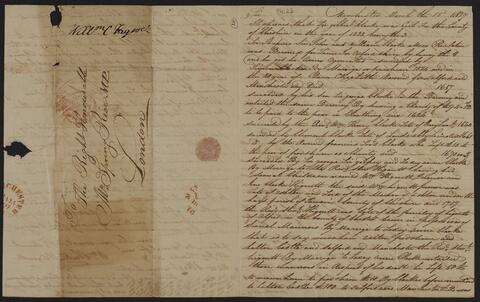
Bereich "Identifikation"
Signatur
Titel
Datum/Laufzeit
- 15 March 1827 (Anlage)
Erschließungsstufe
Umfang und Medium
4 pp.
Bereich "Kontext"
Name des Bestandsbildners
Biographische Angaben
Thomas Spring Rice was born in Limerick on 8 February 1790, the only son in a family of three. His parents were Stephen Edward Rice of Mount Trenchard, county Limerick, and Catherine Spring, only child and heiress of Thomas Spring of Castlemain, county Kerry. He had a distinguished career as a politician, representing Limerick in Parliament from 1820 to 1832, and the borough of Cambridge from 1832 to 1839. He was made Under Secretary of State for the Home Department in 1827, and served as joint Secretary to the Treasury from 1830 to 1834 under Lord Grey. His other appointments included Chancellor of the Exchequer from 1835 to 1839, and Comptroller of the Exchequer from 1835 until his death in 1866. He was raised to the peerage as first Baron Monteagle of Brandon in the county of Kerry on 5 September 1839. In his role as politician, Thomas Spring Rice was instrumental in the authorisation of the ordnance survey of Ireland at six inches to a mile in 1824, and the establishment of the Irish National School system in 1832.
Thomas Spring Rice married twice, firstly (in 1811) Lady Theodosia Pery, second daughter of the first Earl of Limerick, by whom he had eight children. In 1841, following the death of his first wife in 1839, Lord Monteagle married Mary Anne Marshall. There were no children from the second marriage. Following Lord Monteagle’s death on 7 February 1866, the title passed to his grandson and namesake, Thomas Spring Rice (1849-1926).
Thomas Spring Rice enjoyed great popularity in his native city of Limerick. In 1820, he was invited to stand as an election candidate against Charles Vereker in an attempt to free the borough from the corruption of its Corporation and the tight control exercised by the Vereker family. When defeated, Thomas Spring Rice appealed to parliament to have the election result overturned on grounds that many of the Vereker voters were non-resident in the city. The enquiry which followed his petition resulted in the imprisonment of the city Recorder for prevarication and the declaration of Thomas Spring Rice as MP for Limerick. In parliament, he instigated an investigation into the affairs of the old Corporation of Limerick, which resulted in the passing of the Limerick Regulation Act of 1823.
In 1832, Thomas Spring Rice declared that he would not be seeking re-election in the city, mainly owing to his opposition to the proposed Repeal of the Act of Union. From 1832 to 1839, he represented the borough of Cambridge in the parliament. His many contributions to Limerick city are commemorated in the painting The Chairing of Thomas Spring Rice, MP, by William Turner, commissioned by the Limerick Chamber of Commerce in 1822, and a statue by Thomas Kirk, erected by the Barrington family at Pery Square in 1829 on top of a monument designed by Henry Aaron Baker.
Bestandsgeschichte
Abgebende Stelle
Bereich "Inhalt und innere Ordnung"
Eingrenzung und Inhalt
Letter from William Clarke Hignett, Manchester, relating to inheritance duty and the proposed amendments to a related bill. The letter contains extensive notes on the pedigree of the Clarke family.
Bewertung, Vernichtung und Terminierung
Zuwächse
Ordnung und Klassifikation
Bedingungen des Zugriffs- und Benutzungsbereichs
Benutzungsbedingungen
Reproduktionsbedingungen
In der Verzeichnungseinheit enthaltene Sprache
- Englisch
Schrift in den Unterlagen
Anmerkungen zu Sprache und Schrift
Physische Beschaffenheit und technische Anforderungen
Findmittel
Bereich Sachverwandte Unterlagen
Existenz und Aufbewahrungsort von Originalen
Existenz und Aufbewahrungsort von Kopien
Available digitally on the University of Limerick Digital Library at https://doi.org/10.34966/uldl.ew1s-0h93.
